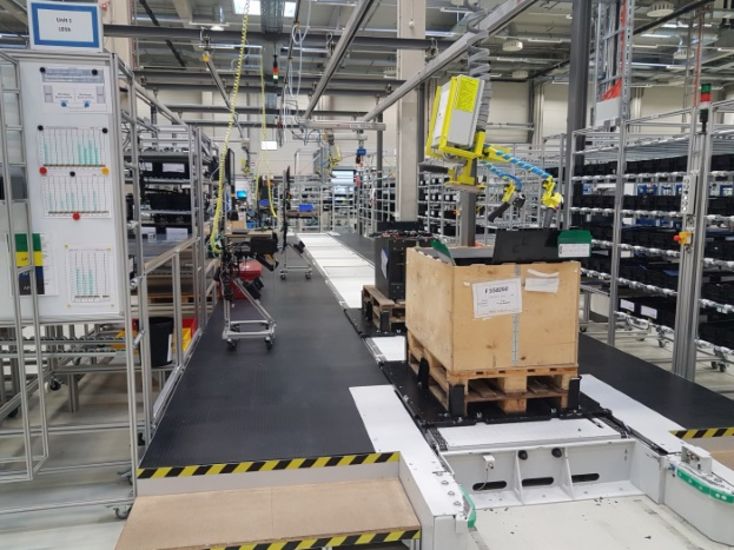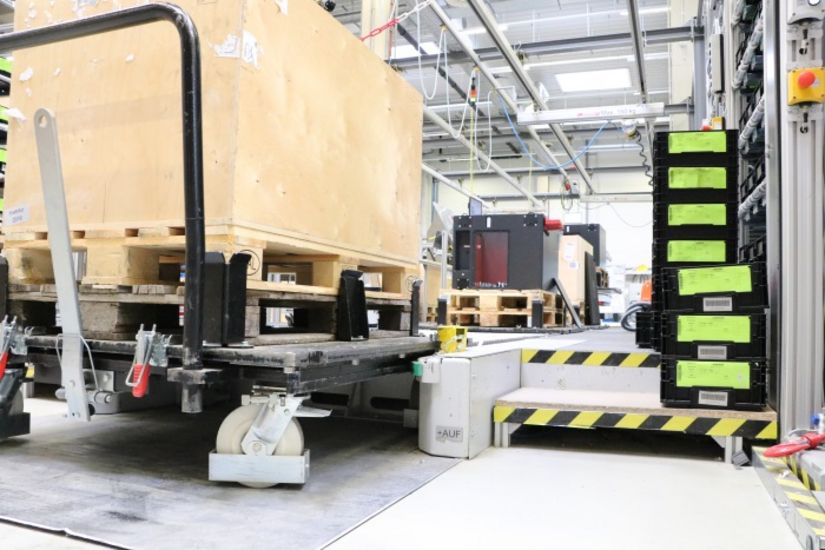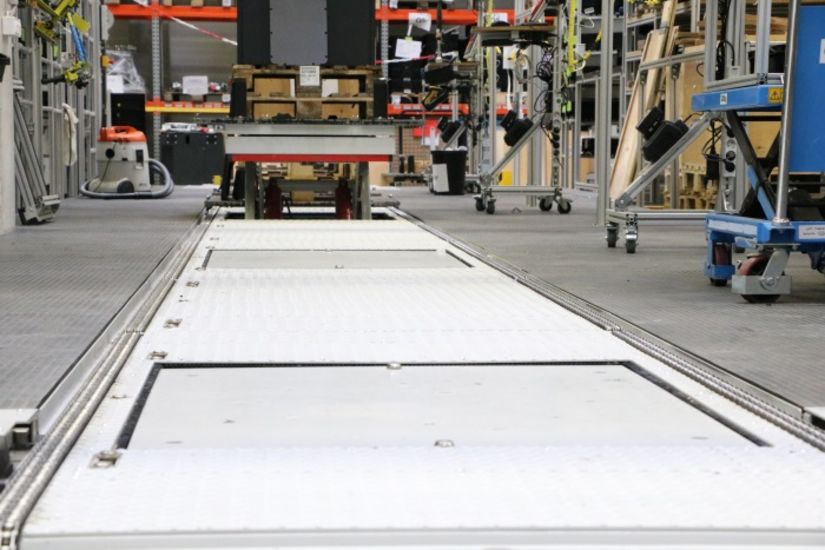
Technology for the Future
The weight of ready-to-install batteries for e-forklifts can be as much as three tons. In order to make their assembly easier for employees and economical, BMZ (Batterien Montage Zentrum) relies on KNOLL type TS-S and TS-G transport systems. Thanks to their close-to-the-floor installation and the combination with transport carts, workpiece and material carriers, these systems fulfill the battery manufacturer's requirements perfectly.
Lithium-ion batteries have been booming for years. This is a circumstance from which the BMZ Group has profited (see box). The company, which manufactures lithium-ion batteries for applications ranging from one-cell to high-volt systems that weigh tons, is consistently experiencing double-digit percentage growth. Its product line includes battery systems for e-bikes, power and garden tools, medical devices, for energy storage, e-vehicles, and industrial applications. Each battery is developed especially for the application and the customer's requirements.
The BMZ Group places great value on offering solutions from a single source, from development – BMZ is responsible for creating approximately 250 new products each year – to prototype construction and its in-house test laboratory, on through to series production, most of which is done in Karlstein near Aschaffenburg. For BMZ, production means the assembly and packaging of the batteries. That is, producing the individual battery cells in a housing with appropriate electronics and a battery management system and installing battery packs of different orders of magnitude.
Approximately five years ago, electrification conquered the industrial truck sector. Linde Material Handling GmbH, one of the world's leading manufacturers of forklifts, has been ordering the batteries for its e-fleet from BMZ since then. With the new customer, there was also a new weight class in BMZ's production halls. Weighing more than a ton, these components cannot be moved manually. The consequence: BMZ invested in transport systems in order to convey the batteries automatically from station to station.
Ergonomic solution for very heavy batteries
After doing extensive research on the Internet and examining other companies' conveyor solutions, BMZ decided to equip the two assembly lines with suspension chain conveyors with accumulating roller conveyors and roller technology from KNOLL, Bad Saulgau. Frank Seither, Team Manager Lean Production, who is responsible for the planning of the assembly systems with regard to cycle time, material provision, etc., explains: "As compared to other conveyor systems - for example those with driverless transport units, low-platform trucks, and industrial trucks - such a line offers the advantage that the components are transported from workplace to workplace without the workers having to do anything." The workplaces are equipped with lifting tables, so that their height can be adjusted individually and they can be turned. This saves time and provides employees with ergonomic benefits.
As reasons for selecting KNOLL, the planner mentions the overall package including technical expertise, intensive support, a good price/performance ratio, and the readiness to implement individual requirements. "What we especially liked about the KNOLL type TS-S and TS-G transport systems was the implementation of low suspension chain technology with a surrounding platform that provides a level surface without stumbling blocks so that no constructive changes have to be made to the hall floor – and in addition the sophisticated combination of transport cart and separate, flat workpiece carriers."
This means that the battery housings to be fitted are on a flat workpiece carrier equipped with a factory-made attachment, which in turn is placed on a transport cart with rollers via tugger train or manipulator. For insertion and removal of the workpiece carrier, there is an automatic insertion/removal aid developed by KNOLL. "This system was of great significance for us, since we were therefore able to avoid obstructive rollers, etc. on the workstations," says Seither.
Another key advantage was the concept of combining the workpiece carriers with a subsequent material carrier. "Some components to be installed are so heavy that we cannot make them available on the Kanban rack," explains the Lean Team leader. "In addition, we need pre-mounted components that are already so large that they do not fit in the rack. Therefore, it's helpful to convey these parts together with the workpiece carrier. In sum: the KNOLL solution seemed ideal for our purposes."
Two lines have been in successful operation since 2016
The first assembly system was designed at the end of 2015 for battery packs weighing up to 1.5 tons; it was put into operation at the start of 2016. "The cooperation with KNOLL was intensive and on a high technical level, so that we were able to clarify nearly all details even during the exploratory phase. That speeded up the implementation enormously," confirms Seither.
Initially, BMZ used this line to install batteries for the StreetScooter e-trucks. Previously, this work was done manually. With automated transport, productivity jumped significantly: from 20 batteries per week to 20 per day. "Of course we also make more manpower available due to the increased demand," qualifies Seither. "But previously we couldn't have produced these quantities, due just to the space requirements for box assembly."
Today, on the former "StreetScooter" line, the company produces energy storage products that weigh just 100 kg. A circumstance about which Jürgen Perlich, Director of Industrial Engineering, positively raves: "The nice thing about a system like this is that we can use it universally if there is production capacity available." Perlich's department is responsible for construction of the standard elements and the operation and maintenance of the system.
120 kinds of forklift batteries
The second assembly line – for components weighing up to 2.5 tons – was put into operation in October 2016. On it, BMZ builds the battery packs for the Linde forklifts mentioned above; currently there are 120 different varieties. The flow of the assembly, which is done nearly individually, is as follows: first the empty housing, the so-called trough, is put on the line. This is a steel body with a wall 10 to 15 mm thick, which by itself weighs 500 kg. "The great weight is designed this way by the customer so that the battery has the necessary intrinsic weight on the forklift," explains Perlich.
After its insertion, the workpiece carrier goes to four workstations. There, the individual cells are placed in the trough, wired to one another, and a battery management system - the so-called technology space plate - is added. The system moves on every 20 minutes. The positioning is controlled by stoppers. "Due to the variant production, the work cycle cannot be optimized 100%. However, the proximity of the stations allows the workers to help one another if there is free capacity." At the last station, the trough is sealed with a cover and then removed. The completed battery goes to final testing on a transport cart; this is done outside of the line.
Capacity expansion with additional KNOLL transport systems
As of January 2020: since the demand for forklift batteries is growing, BMZ is adding another hall for two assembly lines that are in the completion stage. The transport systems for these will be delivered at the beginning of May. Dirk Trumpfheller, whose Production Engineering department is responsible for creating the requirement specifications, procuring special machines, and introducing new technologies, explains: "The conveyor belts for the new assembly lines extend beyond the standard components, which is why our department got involved." Once again, the order was placed with KNOLL, even if quotations were obtained from other suppliers in advance.
Essentially, the new assembly lines, which are now designed for product weights up to three tons, are similar to the first two. BMZ has reused the concept of transport cart, workpiece and accompanying material carrier – and even "fork-free" conveying without forklifts. Since some troughs are on special pallets, the battery manufacturer may not be bound to Euro pallets. Dirk Trumpfheller emphasizes: "The system with KNOLL transport cart and workpiece carriers is optimally suited for all of our logistics needs, for we can make components available on these after assembly for testing systems, charging devices, etc."
Networked and increasingly automated
With regard to system control, BMZ is changing things up. While the previous assembly systems ran largely autonomously, in the future they will communicate with a superior control system. Workers will also receive their work instructions exclusively in digital form. Through interactive dialogue, it is possible to detect work areas that have not been completed, and if necessary, block further conveying. For example, this applies for screw fixtures that must be tested; they are now tracked and coupled with a control system. BMZ also implemented so-called quality gates in the new assembly systems, which affect the product weight, for example. This means that the component is weighed at the last workplace. If the weight differs from a reference value, it can be determined whether all components were installed and which parts are missing. Furthermore, the battery manufacturer now uses a RFID tag for workpiece carrier detection for each product. This way, it is possible to track the components on the line and equip them with important information. In case of a battery fire, a removal scenario was already defined during the planning phase in order to remove the battery from the assembly process in case of emergency.
The battery assembly center
The BMZ Group is a global player in the production of lithium-ion system solutions. The company was established 25 years ago by current CEO Sven Bauer. The corporate group is headquartered in Germany and maintains research and development facilities around the world. Approximately 3000 employees work in a global network at locations in the USA, Germany, Poland, France, Japan, and China in order to be able to guarantee customers quick support on-site. With stable growth of 25 to 30% on average in recent years and sales of EUR 500 million in 2019, the BMZ Group is a European leader in battery production.
BMZ Batterien-Montage-Zentrum GmbH
Zeche Gustav 1
DE-63791 Karlstein
Tel.: +49 6188 9956-0
Fax: +49 6188 9956-900
kontakt@bmz-group.com
www.bmz-group.com
B01_KNOLL_BMZ_122132
Press photo
Press photo
BMZ assembles heavy batteries on KNOLL type TS-S and TS-G transport systems. Picture: BMZ
jpg (4 MB)B01_KNOLL_BMZ_122203
Press photo
Press photo
BMZ assembles heavy batteries on KNOLL type TS-S and TS-G transport systems. Picture: BMZ
jpg (4 MB)B02_KNOLL_BMZ_4603
Press photo
Press photo
For insertion and removal of the workpiece and material carriers, there is an automatic insertion/removal aid developed by KNOLL. Picture: BMZ
JPG (5 MB)B02_KNOLL_BMZ_4611
Press photo
Press photo
For insertion and removal of the workpiece and material carriers, there is an automatic insertion/removal aid developed by KNOLL. Picture: BMZ
JPG (4 MB)B03_KNOLL_BMZ_4600
Press photo
Press photo
The battery housings to be fitted are on a flat workpiece carrier equipped with a factory-made attachment, which in turn is placed on a transport cart with rollers via tugger train or manipulator. Picture: BMZ
JPG (4 MB)B04_KNOLL_BMZ_4593
Press photo
Press photo
The battery manufacturer appreciates the advantages from close-to-the-floor installation of the transport system and the combination of transport cart, workpiece and material carrier. Picture: BMZ
JPG (4 MB)B05_KNOLL_BMZ_4605
Press photo
Press photo
Obstructive rollers, etc. are avoided in the workstations. Picture: BMZ
JPG (4 MB)B06_KNOLL_BMZ_3832
Press photo
Press photo
From L to R: Dirk Trumpfheller, Jürgen Perlich, and Frank Seither agree: "What we especially liked about the KNOLL type TS-S and TS-G transport s systems was the implementation of low suspension chain technology with a surrounding platform that provides a level surface without stumbling blocks without making constructive changes to the hall floor – and in addition the sophisticated combination of transport cart and separate, flat workpiece carriers." Picture: KNOLL
JPG (7 MB)User report
User report BMZ
User report BMZ
pdf (1 MB)





